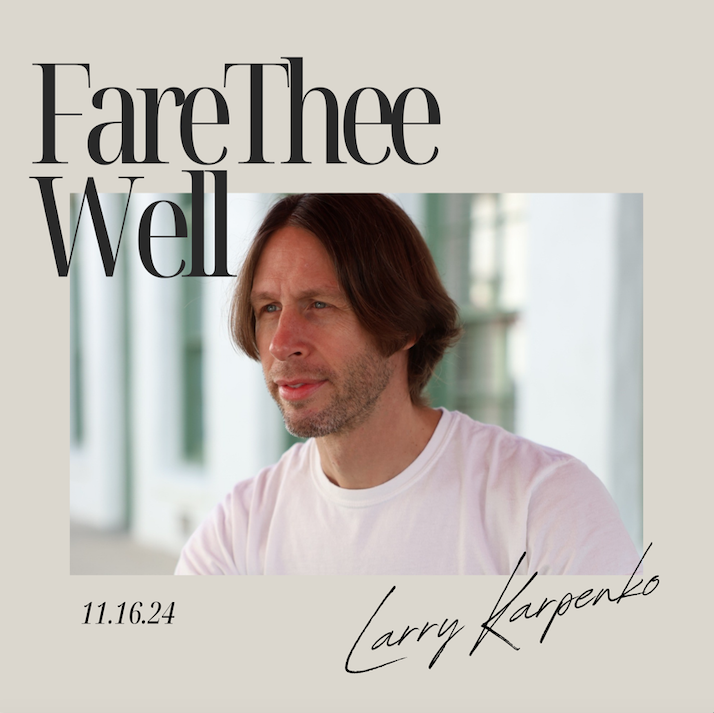Larry Karpenko On the Making Of “Fare Thee Well”
What was the creative process like for this particular song?
The creative process for “Fare Thee Well” was like a whirlwind. The musical backbone of “Fare Thee Well” was from a piano motif, originally called "solace," composed many years ago that I gravitated to when I wanted reflection and peace. After attending my friend's celebration of life funeral service, I was filled with raw emotion of separation, and the melodic phrase “Fare Thee Well” erupted from my lips while playing the arpeggiated chords. A sense of calling out into darkness, or singing into a gray, foggy ocean was experienced. I wanted the musical ideas to mirror life realities; for example, in the intro, a complex drum rhythm was chosen: a 3/4 straight beat superimposed on a 4/4 song, a complexity mirroring the complexity and syncopations of life and the human condition; this creates a wave life action, a push-pull with accelerated moments and contrasting pauses; this is then resolved in the chorus by moving back to a straighter 4/4 drum cadence to relieve tension.
How did you approach the arrangement and composition of the music for “Fare Thee Well?”
One favorite aspect of “Fare Thee Well” is how it's really two songs in one. One element is the sensitive goodbye and wishing of safe departure for the loved one; a safe farewell. The other idea reflects a love song. Descriptive adjectives give mental images of a love relationship and the beauty surrounding the union. I hope audiences are introduced to these complex nuances of love and life and that it leads them to desire art that stirs their senses. Life by XLN Audio captured a human element, a rhythmic pattern to form the foundation hook “Fare thee well, my love.” A minimalistic approach to vocal arrangement involves building sections, adding information for the listener, creating space for reflection, and allowing time for elements to unfold naturally. The climax is the song's bridge, using synthesizers as a sonic contrast to other parts of the song, slow ascending piano arpeggios, like going to heaven. Sounds to craft the emotions included Knifonium Tremod, waving, outer space; Lab V Blade of Canada, whirling, swirling, notes played rising higher and higher; Lab V Arcade Ambiance, gritty saw wave, also pays honor to sounds of Peter Gabriel, whom I respect his creativity, collaboration and musical pursuits. When he sings “Red Rain is coming Down,” there's a synth that has a similar sound and feel. All meant to emphasize nostalgia, reflection of time in the past, good times, innocence; Lab V Jun Dubstep, deep pulsating, like a heartbeat, life support, intense dream, nightmare, migraine, powerful grounding bottom end, earth-shattering. Lastly, an outro fade out was chosen; not as common of an ending but effective in giving an illusion that the music never stops; it keeps playing but it or we drift out of ear-shot.
What impact do you hope "Fare Thee Well" will have on your audience?
I want audiences to have a sense of living their life to the fullest, realize every moment is important, and be deliberate about loving others. I want audiences to see the beauty of a life well lived, cherish the back-and-forth banter of relationships, and contemplate how deeply love affects us.
Can you tell us more about you as an artist?
As an artist, I am on a complex and exhilarating growth path. Complex in that I love to write songs, I love to produce songs, and I love to tell stories; this tasks me with fulfilling many roles, constantly adjusting gears, often looking at new perspectives. I am a diverse songwriter; this year I decided to release music to show this diversity, music ranging from topics such as love, longing, farewell, solace, God, equality, prayer, and more.
What’s the most profound emotional experience you’ve ever had while creating or performing music?
In the past year, I have cried in the studio more than I ever had. I joke that a tissue box is now an important part of my studio setup. There have been numerous times I have sat back and listened to the art, and when the picture begins to materialize, I am often overwhelmed with emotion. Seeing a long-imagined song formulate from mind to material; hearing a musical idea fit together; sharing a new song with others—it is a transformative experience.
